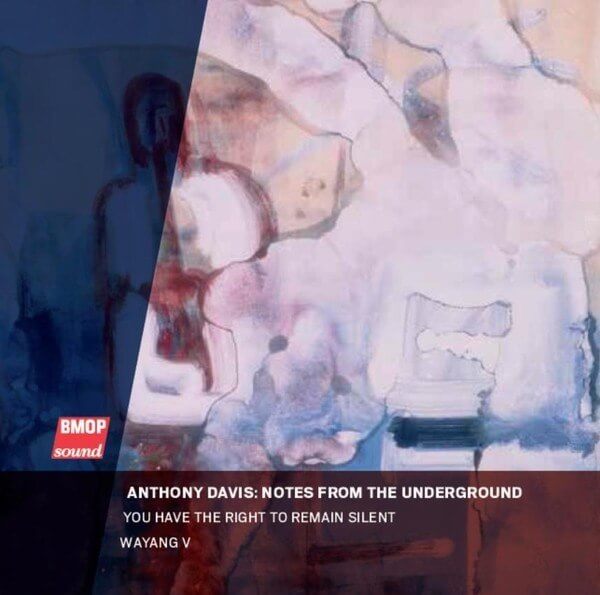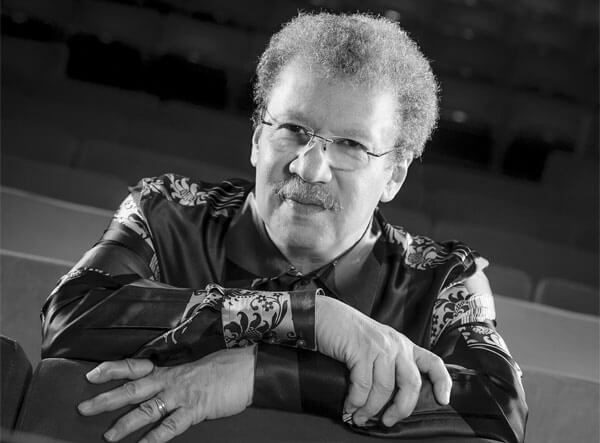 Practically every work by composer Anthony Davis could have been composed today. Long, overlapping rhythmic patterns and formulas that pit portions of the orchestra against each other, as harmonically rich and textured as the doleful tapestries of inequalities in the United States, is a central component of Davis’ oeuvre. What Davis calls his “clones,” cyclical structures and serpentine lines that undergo little internal change, are laid end to end, becoming long chains, moving at contrasting speeds against each other. Davis’ music thrives on these simultaneously complicated and transparent stratifications, at times sublime, at times thunderous and swarming. Yet, there is a sense of progress and freedom within these webs of sound that exhibit clarity and immediacy, with Davis’s work sounding consistently new and novel.
Practically every work by composer Anthony Davis could have been composed today. Long, overlapping rhythmic patterns and formulas that pit portions of the orchestra against each other, as harmonically rich and textured as the doleful tapestries of inequalities in the United States, is a central component of Davis’ oeuvre. What Davis calls his “clones,” cyclical structures and serpentine lines that undergo little internal change, are laid end to end, becoming long chains, moving at contrasting speeds against each other. Davis’ music thrives on these simultaneously complicated and transparent stratifications, at times sublime, at times thunderous and swarming. Yet, there is a sense of progress and freedom within these webs of sound that exhibit clarity and immediacy, with Davis’s work sounding consistently new and novel.

Three of Davis’s works are presented on a 2014 Boston Modern Orchestra Project release – titled Notes from the Underground – in a beautiful package with confident and robust performances from BMOP under Gil Rose, with an effortless, incisive, and chillingly present performance by clarinetist J. D. Parran. Composer George Lewis provides an exceptional and insightful critical essay in the liner notes, and Davis himself provides extensive program notes for each work, clarifying for a listener his compositional approaches and motivations. With two works from the 1980s (Wayang V, Notes from the Underground) and a more recent, streamlined, and poignant work from 2007 (You Have the Right to Remain Silent), the recording is a glimpse of the composer’s roots and his developed voice.
Wayang V (1984) is the oldest work on the recording, though a freshness of harmony and playfulness, assisted by Davis himself with a warm, easy performance on piano, helps the work transcend era. Wayang V is one of many such works, a kind of concerto between both the piano and orchestra, and within the orchestra itself, inspired by the music of Indonesia – indeed, the final movement “Kecak” owes its techniques, vibrant colors, and rhythmic energy to the eponymous Balinese chant. Davis claims a mantle from many places; in Wayang V, the clearest influences are Bali, Lou Harrison, and Messiaen.
Notes from the Underground (1988), premiered by the American Composers Orchestra, has its origins in Duke Ellington, though contains as many inflections of jazz as it does colotomic structures. As Davis explains, the work ignites in the relatively short “Shadow,” with a complicated polyrhythmic, palindromic, multi-phrased system unfolding in “Act.” Superimposing 20/8 and 11/9 patterns along with 12, 25, and/or 27 beat patterns, Davis creates a world of multiple moving parts clearly moving with and against one another. A lesser orchestra would likely be muddled, but Gil Rose’s direction heightens and clarifies this action, to where we can almost see both the web and every strand in the web that Davis weaves. The effect is insistent, static, clever, and anxious – and fantastically performed.

The most recent work You Have the Right to Remain Silent (2007) is unique for its small chamber size (flute, oboe, bassoon, horn, trumpet, trombone, 3 percussionists, harp, single strings) and its featured soloists: Earl Howard gives a magical and colorful turn on a Kurzweil synthesizer, and J. D. Parran gives us a lesson on how to make practically every sound imaginable on both the clarinet and the contra-alto clarinet. You Have the Right… is, as George Lewis puts it, a kind of shadow theater where Davis is pulling the strings in what is very much a sadly repeated scenario: pursuit, arrest, confinement, refusal, and repetition. The work, of course, takes its cue and inspiration from the Miranda Warning, and fragments of the paragraph, ubiquitous in cop dramas and civics textbooks, appear throughout the work. The piece also plays upon the Cageian concept of “Silence” – here rephrased and repurposed as a form of privilege, evoking Martin Luther King’s statements about silence being betrayal and continued allowance of oppression.
[Tweet “Davis’s music points to who we are, who we should be, and who we were.”]
You Have the Right is alarmingly prescient. For those who may not be familiar with Anthony Davis or his work, Davis is black. In the landscape of American art music composition, black voices are far too few, and political perspectives from this unique vantage point are achingly rare. New York City’s controversial “Stop and Frisk” policy remains on the books; “Stop and Frisk” overwhelmingly targeted minorities – young black men being the most-often targeted. As I write this review, the Ferguson, Missouri police are only now backing down after the killing of Michael Brown, Jr., an unarmed black man, at the hands of a police officer. I first listened to this recording within hours of learning about Eric Garner, an unarmed New York man and asthmatic who died due to compression of the neck and chest due to force applied by NYPD officers. During 2005 and 2006 – presumably close to when Davis composed You Have the Right – numerous unarmed black men and women met their fate as Brown and Garner have (The Danziger Bridge incident; Timothy Stansbury; Sean Bell; Aaron Campbell; the list, sadly, continues), at the hands of the uniformed officers who are oath-sworn to protect them.
To say that You Have the Right… is a direct statement of activism may be presumptuous, but the evidence points to a compelling case. The usage of the Kurzweil synth in the work is striking – at times for its somewhat dated timbres, at others how it samples and mimics and distorts the clarinet and percussion, and mostly how Earl Howard mercurially shifts between the two worlds (and how Davis structures these shifts) and seamlessly interacts with the worlds. Mediator, judge, helpful attendant, or something far more sinister? We’re not sure. Parran’s brilliant playing elicits shrieks of terror, delight, fury, and more, and the primal vocalizations and clarinet multiphonics point to a neglected, wrongly-accused suspect, mistreated and misunderstood by the “authorities.” The “authorities” here is the chorus of voices of the chamber ensemble that flatly proclaim vestiges of the Miranda text: initially, the rhythmic chanting of the Miranda warning comes off as uncompelling, dry, flat. But that too is a pernicious vision: what should be a guarantee of sacred Constitutional rights comes off as routine, devoid of passion, like those uttering it no longer care about it, and those hearing it have no reason to ever believe it. It becomes a plaything in the mouths of the orchestra and something tossed as carelessly about as a purse, or keys, or a jacket. The effect of You Have the Right… as a whole is psychologically terrifying, initially subtly; only after ample circumspection can the full weight be felt.
George Lewis, in his included essay, claims that Davis’s music “points the way to an American musical culture that can connect its classical music with an African diasporic sonic culture. […] More broadly, this music poses the question of what a new classical music might sound like in a post-colonial world. The work exhibits a heterogeneity that references a complex mix of cultures and traditions.” I should perhaps underscore the usage of the word complex, for Davis’s work, as presented on this album, reflects uniquely American aspirations – the “melting pot” (though it be cliché) idea, equal treatment and honor of source material, preservation of one culture while advancing it – and uniquely American traits (vis-à-vis jazz, structured improvisation, blues), while making pretty clear statements about the American present. Davis’s music points to who we are, who we should be, and who we were; Gil Rose and the Boston Modern Orchestra Project do faithful justice to Davis’s work, giving it a clear and present voice, moving and compelling.
























